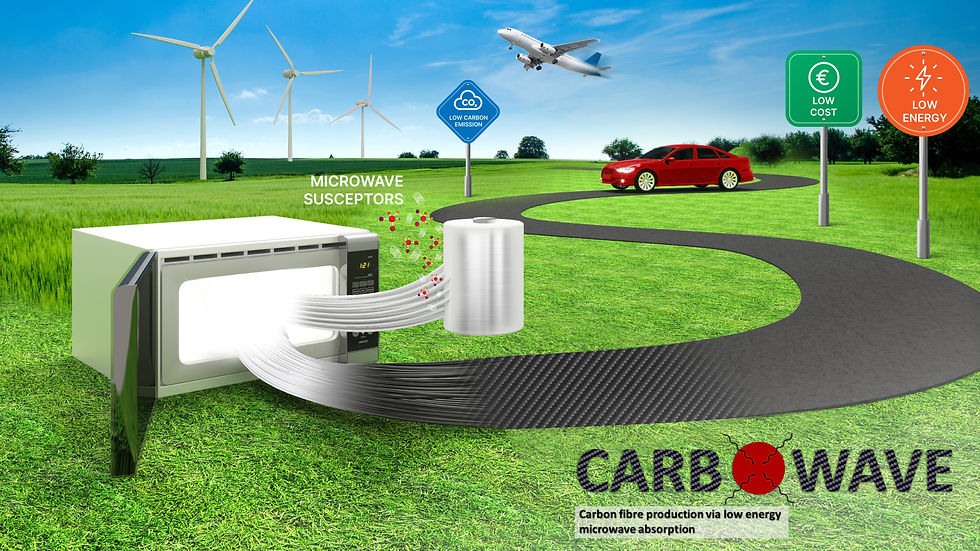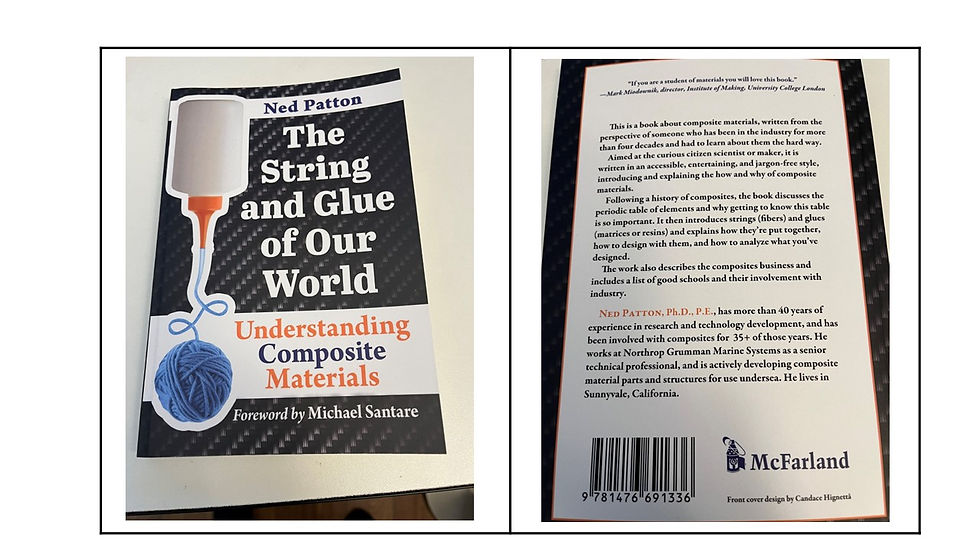Update on Microwave Processing to Make Carbon Fiber
- Ned Patton

- Aug 19
- 6 min read
I have written about this topic before, but a recent article in Composites World brought it back up again. My initial post was about Microwave Chemical in Japan, so I was quite interested when I saw this article in Composites World. Apparently there is a new consortium in Europe that is working out how to process carbon fiber both using focused microwaves and also high energy plasma.

This project (CARBOWAVE) is actually a consortium formed by several European educational institutions and companies, led by the University of Limerick, and with members from Germany (Fraunhofer, DITF, Muegge), Italy (Stellantis which owns the Fiat brand), France (Microwave Technologies Consulting), and Spain (Universitat de Valencia), as well as two other companies in Ireland, Eire Composites and Juno Composites.
The European model for technology development is far less restrictive than the US is about Universities, Governments, and private companies all collaborating and providing resources and talent. They are also a lot less sensitive about sharing intellectual property as we are here in the US. In addition, the EU generally is very much in favor of funding large technology development projects when it gives the EU a technological advantage. Hence the large number of leading edge European consortia developing technologies that push at the boundaries of what is possible.
The University of Limerick is the overall coordinator of Project CARBOWAVE which is funded at over 1 million Euros. At the university they have developed a coating that they put on the PAN fiber to make the fiber a better absorber of microwave energy. They discovered that a fairly low power microwave with their special coating on the PAN fiber could save as much as 70% of the energy used over traditional carbon fiber manufacturing methods. And they produced some high quality carbon fiber using a fairly common and inexpensive domestic microwave oven.

This project is part of the “Horizon Europe” initiative instigated by the European Commission and funded by the EU. There are several of these consortia working on a number of different technologies. I have written about a couple of them in the past, but this one struck me as a real breakthrough. Having a company like the Fiat Research Center (part of Stellantis – the folks that bring you the Mercedes and Chrysler brands) being a part of this leads me to think that the European automotive industry is serious about lowering weight while keeping costs down and building much less carbon intensive automobiles. They have already gone toward EVs in a very large way, so this is another example of the progress that is being made over across the pond.
This consortium appears to have all of the relevant organizations, including Government, University, and Commercial research centers involved and also appears to have developed something that can be scaled up rather rapidly. If it works in your kitchen microwave, that can scale quickly.
It appears that the leadership of CARBOWAVE have already started this process, as evidenced by the plasma driven PAN fiber oxygen stabilization furnace facility at DITF in Germany. This furnace uses about 50% less energy than the traditional gas fired stabilization furnaces because the high temperature plasma is electrically generated. Using renewable energy makes this a very sustainable process.

CARBOWAVE strikes me as very similar to another European led consortium I have written about that is scaling up technology to recycle fiberglass from end of life wind turbine blades and boat hulls. This is of course the consortium led by Beneteau that involves Composite Recycling, Owens Corning, Arkema, and a few others that is scaling up the Fiberloop thermolysis technology to enable them to handle hundreds of tons of end of life fiberglass material. The glass fiber that results from their process is being woven back into usable glass fiber products that will be sold by Owens Corning into their fiberglass fabric business. While this is not microwave processing of carbon fiber, it is just another example of a consortium being led by the Europeans to develop sustainable materials processing for their future.
And, as I was looking into this entire subject a bit more, I discovered another organization that developed another microwave assisted plasma treatment and microwave carbonization treatment of PAN fiber to make carbon fiber. Oak Ridge National Laboratories in Oak Ridge, Tennessee developed and patented a process for turning PAN fiber into carbon fiber that should save as much as 50% of the energy of traditional carbon fiber processing and will operate at higher fiber production rates than the conventional gas and oil fired high temperature carbonization ovens traditionally used. They developed this process apparently in the early to mid 2010’s and have had it available for licensing since then. The information about this is fairly sketchy and brief, but at least it is out there and available for licensing.
And of course, Microwave Chemical and Mitsui Chemical have also partnered to scale up Microwave Chemical’s process as well. They have even built a new factory in Japan that is intended to scale up the Microwave Chemical technology for making carbon fiber.

These companies are also using a newer metric for lowering their carbon footprint, called Life Cycle Assessment (LCA). This is a fairly new but well established process (less than 10 years old) whereby the company doing the assessment tallies up all of the sources and sinks of carbon and carbon dioxide for their entire process, including sourcing the materials, transportation and logistics emissions, emissions from their energy source for process heat, and all of the other various and sundry things that must be accomplished in order to sell a finished product. Their life cycle assessment showed, given that they can use renewable energy for process heat, that their process has the potential to save up to 90% of the carbon dioxide emissions of traditional means of making carbon fiber.
All in all this looks to me like the future of carbon fiber manufacture. And when the plant-based fiber precursors finally overtake the petroleum-based precursors, we will finally achieve a completely sustainable carbon fiber manufacturing business that can produce high quality carbon fiber using only renewable energy and plant based sources, and that will be half the cost of current petroleum-based carbon fiber. The future looks to me like it is very bright.
That’s about it for this week. As always, I hope everyone that reads these posts enjoys them as much as I enjoy writing them. I will post this first on my website – www.nedpatton.com – and then on LinkedIn. And if anyone wants to provide comments to this, I welcome them with open arms. Comments, criticisms, etc. are all quite welcome. I really do want to engage in a conversation with all of you about composites because we can learn so much from each other as long as we share our own perspectives. And that is especially true of the companies and research institutions that I mention in these posts. The more we communicate the message the better we will be able to effect the changes in the industry that are needed.
My second book, which may be out in the late fall, is a roadmap to a circular and sustainable business model for the industry which I hope that at least at some in the industry will follow. Only time will tell. As I have said before, my publisher and my daughter have come to an agreement about the cover. So, as usual I’ve included the approved cover at the end of this post. Let me know whether or not you like the cover. Hopefully people will like it enough and will be interested enough in composites sustainability that they will buy it. And of course I hope that they read it and get engaged. We need all the help we can get. That is why I wrote the book in the first place – to get the word out there for people to begin to adopt these practices.
Last but not least, I still need to plug my first book. “The String and Glue of our World” pretty much covers the watershed in composites, starting with a brief history of composites, then introducing the Periodic Table and why Carbon is such an important and interesting element. The book was published and made available August of 2023 and is available both on Amazon and from McFarland Books – my publisher. However, the best place to get one is to go to my website and buy one. I will send you a signed copy for the same price you would get charged on Amazon for an unsigned one, except that I have to charge for shipping. Anyway, here’s the link to get your signed copy: https://www.nedpatton.com/product-page/the-string-and-glue-of-our-world-signed-copy. And as usual, here are pictures of the covers of both books.





Comments